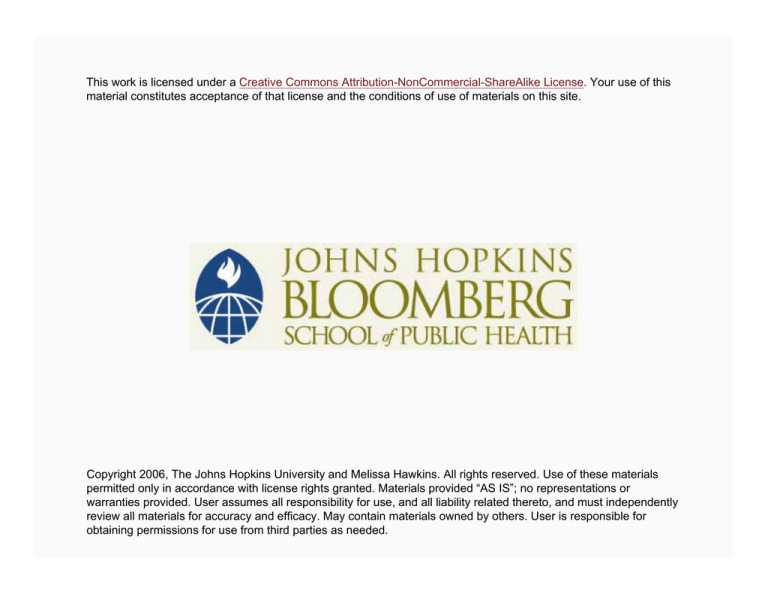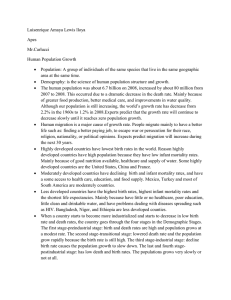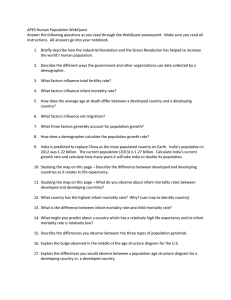
This work is licensed under a Creative Commons Attribution-NonCommercial-ShareAlike License. Your use of this
material constitutes acceptance of that license and the conditions of use of materials on this site.
Copyright 2006, The Johns Hopkins University and Melissa Hawkins. All rights reserved. Use of these materials
permitted only in accordance with license rights granted. Materials provided “AS IS”; no representations or
warranties provided. User assumes all responsibility for use, and all liability related thereto, and must independently
review all materials for accuracy and efficacy. May contain materials owned by others. User is responsible for
obtaining permissions for use from third parties as needed.
The Epidemiology of Infant Mortality I: Terminology
and Immediate Causes
Melissa Hawkins, PhD
Johns Hopkins University
Section A
Standard Terminology in Reproductive Health
Standard Terminology in Reproductive Health
Rate
− Measures the frequency of an event within a particular
population during a given period of time
Ratio
− Indicates a relationship between one element and a
different element
− Individuals in the numerator do not have to be part of the
denominator
4
Live Birth Terminology
A live birth is defined as "the complete expulsion or
from the mother of a product of human conception,
irrespective of the duration of pregnancy, which, after such
expulsion or extraction, breathes or shows any other
evidence of life, such as a beating heart, pulsation of the
umbilical cord, or definite movement of voluntary muscles,
whether or not the umbilical cord has been cut or the
placenta is attached"
Notes Available
5
Live Birth Terminology: Categories of Gestational Age
Pre-term
− Infants born through the 37th week
Term infants
− Infants born between the first day of the 38th week and
the last day of the 42nd week of gestation
Post-term
− Infants born from the beginning of the first day of the
43rd week onward
6
Live Birth Terminology: Categories of Birth Weight
Normal birth weight
−
Low birth weight (lbw)
−
Birth weights greater than or equal to 2500 grams
Birth weights less than 2500 grams
Very low birth weight (vlbw)
−
Birth weights less than 1500grams
7
Live Birth Measures
Crude birth rate
− Impact of fertility on population growth by relating the
total number of births during a calendar year to the total
population
General fertility rate
− Relates the number of births within the general
population to the population "at risk" (i.e., women of
reproductive age)
8
Fetal and Infant Mortality Terminology
Infant death is "any death at any time from birth up to, but
not including, one year of age (364 days, 23 hours, 59 minutes
from the moment of birth)"
Notes Available
9
Fetal Mortality Terminology
Fetal mortality indices express the probability of pregnancies
within specific populations
− Fetal death rate—the number of live births and the
number of fetal deaths comprise the denominator
(population at risk of fetal death)
− Fetal death ratio—only uses the number of live births in
the denominator
10
Fetal Mortality Terminology
AAP and ACOG recommend reporting fetal deaths by
gestational age and birth weight
Fetal death calculations do not include induced terminations
of pregnancy
Currently, there is no national system for reporting induced
terminations of pregnancy within the U.S.
11
Infant Mortality Terminology
Infant mortality indices indicate the likelihood that live births
with particular characteristics will die (or survive) during the
first year of life
Infant death may occur during the neonatal period (prior to
the 28th day of life)
Infant death may occur during the post-neonatal period (from
28 days of life up to one year of life)
12
Infant Mortality Terminology
For all three indices, the number of live births during a
calendar year represents the population at risk
− Another denominator for the post-neonatal mortality
rate—number of live births minus the number of
neonatal deaths, which is a more appropriate
representation of the population at risk of dying during
this period
13
Neonatal Mortality Terminology
Neonatal period can be further subdivided
− Neonatal Period I—birth through 23 hours and 59 minutes
− Neonatal Period II—end of 24th hour of life through six
days, 23 hours and 59 minutes
− Neonatal Period III—end of 7th day through 27 days, 23
hours, and 59 minutes
14
Perinatal Mortality Terminology
Indices for perinatal mortality combine both fetal and infant
deaths within the first few days or weeks of life
Assumption is that similar factors may be responsible for
deaths occurring both shortly before the expected date of
delivery and shortly after delivery
15
Perinatal Mortality Terminology
Perinatal death is also divided into three different periods
− Perinatal Period I—infant deaths < 7 days + fetal deaths of
28 weeks or >
− Perinatal Period II—infant deaths < 28 days + fetal deaths
of 20 weeks or >
− Perinatal Period III—infant deaths < 7 days + fetal deaths
with 20 weeks or >
16
Maternal Mortality Terminology
A maternal death is "the death of a woman from any cause
related to or aggravated by pregnancy or its management
(regardless of duration or site of pregnancy), but not from
accidental or incidental causes"
Death resulting from complications of induced abortion is
considered a maternal death
Notes Available
17
Maternal Mortality Terminology
Maternal mortality indices express the likelihood of a
pregnant woman dying from causes associated with
pregnancy, childbirth or the puerperium
The number of live births is used as a proxy for the population
of pregnant women
18
Maternal Mortality Terminology
Population at risk should include all live births, induced
terminations of pregnancy, and fetal deaths during a given
period of time
Under the current system, it is not feasible to identify every
woman at risk
19
Maternal Mortality Measures
WHO defines a maternal death as death to a pregnant woman
within 42 days of the end of pregnancy
AAP and the ACOG recommend that maternal mortality
statistics be tabulated in two ways
− Without limitation on when death occurs
− Maternal deaths that occur within 42 days of the end of
pregnancy
20
Maternal Mortality Measures
Interest has shifted to perinatal outcomes in developed
countries because of declines in maternal mortality
Developing countries have not yet experienced this trend
− Type of data that exists differs
WHO recommends that birth weight, and not gestational age,
is used to obtain accurate perinatal health statistics
21
Section B
Birth Weight, Gestational Age, and Infant Mortality
Birth Weight, Gestational Age, and Infant Mortality
Distribution of birth weight in the U.S.
Determinants of low birth weight
Birth weight, gestational age, and infant mortality
23
Distribution of Birth Weight in the U.S. Population
24
Determinants of LBW
LBW results from two processes
− Shortened duration of pregnancy (preterm birth)
− Intrauterine growth that is less than expected for the
length of gestation [intrauterine growth retardation
(IUGR) or small for gestational age (SGA)]
25
Determinants of LBW
LBW infant born at 40 weeks results from IUGR
Preterm infant may be LBW but have an appropriate weight
for its gestational age
− LBW only because it was born early
Preterm infant may also be growth-retarded
− LBW because of both its shortened gestation and its
growth retardation
26
Determinants of LBW
GA
LBW
NORMAL BW
> 37 weeks
IUGR
Normal
< 37 weeks Preterm and/or
IUGR
Preterm
27
Perinatal Mortality
Relation of perinatal mortality to BW . . . see inverse
relationship, as perinatal mortality decreases sharply as birth
weight increases
See an up turn at the higher ends of birth weight also
28
Relation of Perinatal Mortality Rate to Birth Weight
Source: Adapted by CTLT from Shapiro, S., McCormick, M.C., et al. (1980). Relevance of correlates
of infant deaths for significant morbidity at one year of age. Am. J. Obstet. Gynecol. 136: 363-373
29
Birth Weight and Gestational Age
Birth weight is a powerful predictor of infant mortality
LBW infants are 21 times more likely to die within the first
year of life than normal weight infants
VLBW infants are 87 times as likely to die as normal-weight
infants
30
Birth Weight and Gestational Age
Are LBW babies at high risk of dying because they are small or
because they are pre-term?
− Small proportion of mortality is accounted for by GA at
delivery
− Birth weight appears to be the stronger predictor
Gestational age is in the causal pathway leading to higher
birth weight
31
Section C
Causes of Infant Death
Infant Mortality Rates by Race
IMR rates by race in the U.S., 1975–2002
See continual decline in infant mortality rate
Also, see black rate consistently higher, close to double (and
the gap is widening in recent years)
33
Infant Mortality Rates by Race: United States, 1975–2002
30
25
20
All Races
Black
White
15
10
5
0
1975
Notes Available
1980
1985
1990
1995
2000
2002
34
Infant Mortality in the U.S.
2002—overall infant mortality rate was 7.2 infant deaths per
1,000 births
− Mortality rates were lowest for infants born to Asian and
Pacific Islander mothers (5.1)
− Followed by white (5.8), Hispanic (5.7), American Indian
(9.0), and African-American (14.4)
35
Causes of Infant Death
Deaths from SIDS have been decreasing, possibly due to
changes in recommended sleep positions for infants
Unintentional injury deaths, on the other hand, have been
increasing
36
Leading Causes of IM, 2000
Perinatal causes top the list
− Congenital anomalies
− Pre-Term Birth (PTB)/Low Birth Weight (LBW)
− Sudden Infant Death Syndrome (SIDS)
− Problems related to complications of pregnancy
− Respiratory Distress Syndrome (RDS)
37
Causes of Infant Deaths by Race in the U.S.
Source: Adapted by CTLT from NCHS. Infant Mortality U.S. (2004), 53(5).
38
Causes of Neonatal Mortality
Causes of Neonatal Mortality
LBW and pre-maturity and their resulting disorders are most
common, followed by congenital anomalies, and then SIDS
Causes of Post-Neonatal Mortality
SIDS is the number one cause in the post-neonatal period for
both black and white infants, followed by congenital
anomalies, infections, and injuries
39
Post-Neonatal Mortality Rates by Cause and Race in the U.S.
Source: Adapted by CTLT from NVSR, 52 (9) (2003).
40
Causes of Infant Deaths
The only cause of post-neonatal death that has been
increasing is that due to perinatal conditions (RDS, birth
trauma, complications of LBW, intrauterine hypoxia/birth
asphyxia)
May be due to the increased survival of infants suffering from
these conditions in the neonatal period, who then go on to
die in the post-neonatal period
41
Causes of Infant Deaths
Mortality from homicide has also been increasing overall
(although decreases in 2001)
− 1993—the IMR per 100,000 live births due to homicide
and accidents was 7.2 and 18.3, respectively
− 1999—they were 8.0 and 25.7
− 2001—6.9 and 21.6
42
Trends in Preterm Birth
Rate of PTB has risen steadily in the U.S.
Since 1999, pre-maturity and LBW has been the leading cause
of neonatal mortality in the U.S.
Promising results of 17P to reduce recurrent PTB
Research to understand the factors that contribute to
disparities in perinatal outcomes include the following:
− Infections/inflammation, stress/racism, SES, clotting
abnormalities, nutritional factors, and genetic
predispositions
43







